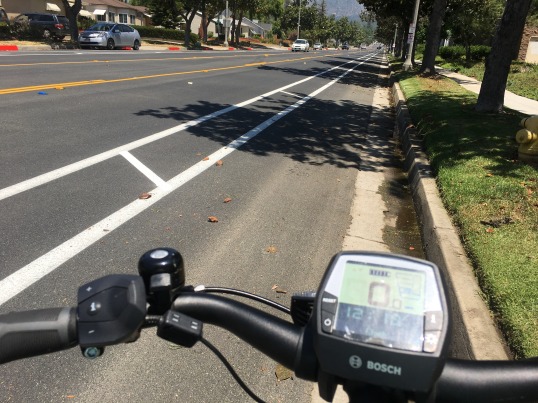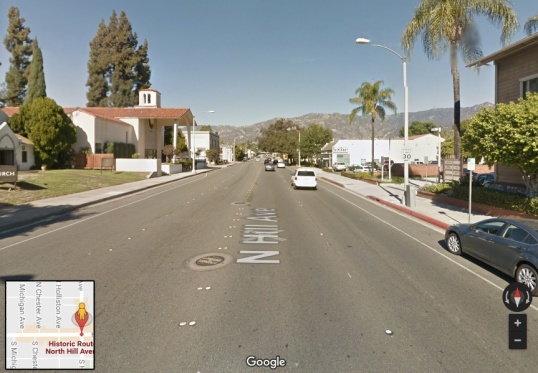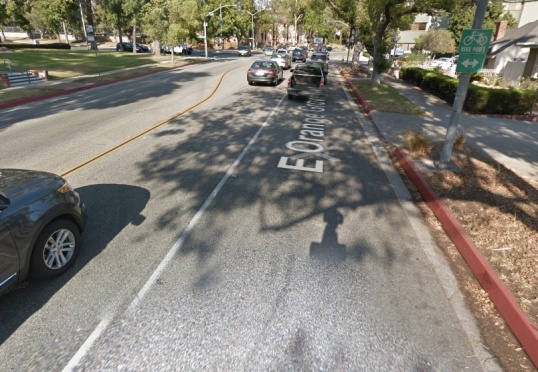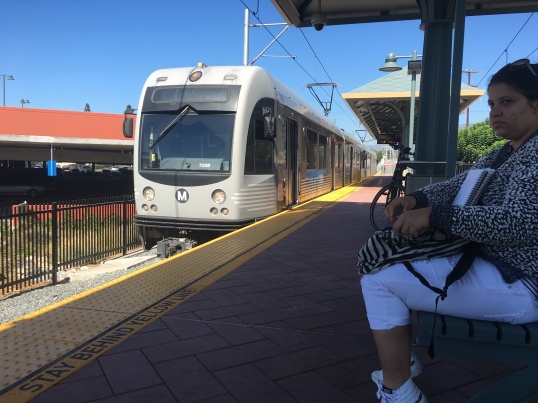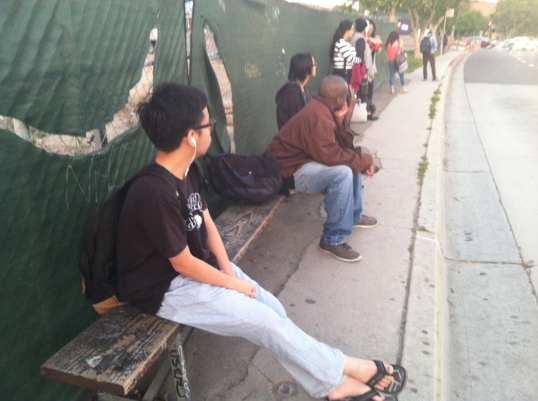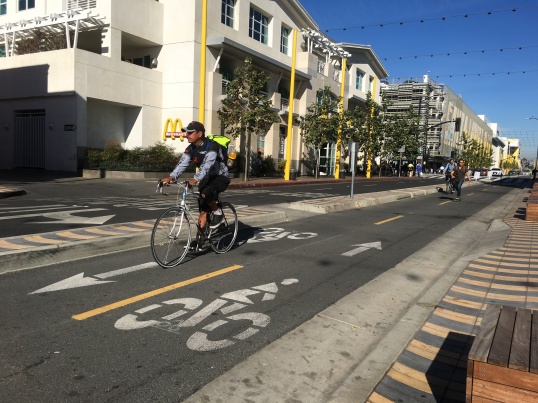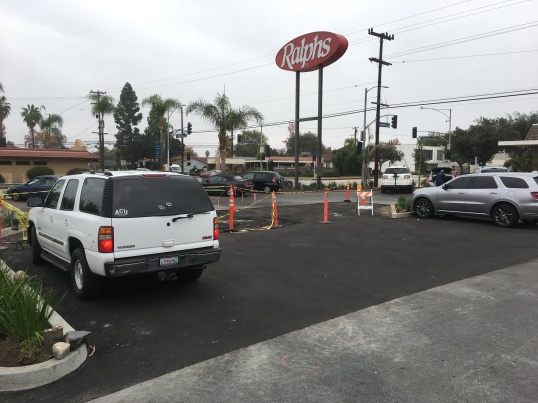Advice for a new bike commuter
One of my friends, a former student, asked me for some advice on social media for getting started bike commuting to the Gold Line commuter rail here in L.A.:
“What’s the best way to get started taking public transportation? The gold line is great, but I currently live 8 mi away from the closest station and another 1.5 miles from my work. I have so much gear that I bring to work (purse, lunch, gear for softball, etc.) so that’s a huge concern of mine with biking to and from stations. Any thoughts on how to get started? What equipment do you suggest?”
It’s great question, of course, and one that a lot of people have probably considered at one time or another. I wanted to use this opportunity to provide some thoughts on getting started and on equipment that would be useful to anyone thinking about bike commuting with transit.
The main concern my friend has is transporting gear on her bike, in this case “purse, lunch, gear for softball, etc.”). I’m assuming that softball gear includes a uniform, glove, and pair of cleats. She also might have undergarments, towel, water bottle, and batting gloves, in addition to a purse and a small lunch bag. These items will pack into a couple of utility panniers (one for each side of your rack). My personal favorite is the Banjo Brothers market pannier, which holds quite a bit and comes with handles and a shoulder strap, so you can carry your gear from your bike to the softball diamond. There are other similar products out there, and they really are versatile. A water bottle cage mounted to your bike frame will hold your water bottle.
 Banjo Brothers market pannier (photo: Banjo Brothers).
Banjo Brothers market pannier (photo: Banjo Brothers).
 My Trek XM700 e-bike with my swim gear in a Banjo Brothers market pannier.
My Trek XM700 e-bike with my swim gear in a Banjo Brothers market pannier.Now, if you also need to carry a batting helmet and bat, that does create a little more of a logistical challenge. Your softball duffel bag can probably be bungee-corded to your rear rack, but you’ve got to make sure it’s secure, so several bungee-cords or a bungee net may be necessary. I’ve rigged a carrier made from PVC pipe for my trekking poles for hiking in the local mountains (see photo), which could also work for a bat.
 I rigged a holster for my trekking poles that can be attached to the rack via zip ties and/or bungees. Pannier holds my hiking gear. Something similar might also work for softball bat.
I rigged a holster for my trekking poles that can be attached to the rack via zip ties and/or bungees. Pannier holds my hiking gear. Something similar might also work for softball bat.Another possibility for gear and a softball bat is a trailer. Most bike cargo trailers are too big for the Metro, but one product that would work is the Burley Travoy trailer, which would hold all your softball gear, and detatches quickly and would be no bigger than a luggage carrier when on the train. I’ve not used the Travoy, but reviews are overwhelmingly positive. Baskets are also good for carrying bulky items. Some of them fit on the back and others on the front.
What kind of bike? Well, that’s a loaded question. You see, bikes aren’t a one-size-fits-all type of thing. Different tire sizes, different frame styles and materials, different frame geometry, different drivetrains, different brakes. The list goes on. Generally speaking, commuter bikes tend to be a bit sturdier (and just a little heavier) than a lightweight racer. Some people modify mountain bikes, but this is only a good idea if the bike has eyelets on the frame to mount a rack and fenders.
For commuting, the essentials are (in no particular order): lights, white light up front and red light in the rear. I recommend a rack, usually mounted on the rear of the bike, but some bikes can be outfitted with front racks and baskets, too.
Gears: if you’re going to be riding in a hilly area or carrying stuff (especially uphill), you’ll want a bike with a wide range of gears. On the other hand, some people like the simplicity of lightweight single speed bikes.
Fenders are definitely a good idea if you’re going to ride in wet weather, since they keep you dry when the pavement’s wet. Take an extra bungee cord to help secure your bike on the Metro, especially if you’re going to be on the train for a while. Otherwise, you can just stand with your bike.
Helmet? By law only riders under 18 are required to wear one. I almost always wear one, but I don’t scold people who don’t. Exceptions: if I’m going for a slow, short ride in my immediate neighborhood, or the bike path at the beach or an open streets event like CicLAvia. Otherwise, I wear one.
Try different bikes. If you go to a local bike shop and they have a bike you like, sit on it, try it out for size and comfort. They should let you take it for a test ride. Try changing the gears while you ride and get the feel for the bike.
The important thing to remember is this: you should feel comfortable on the bike. The advantage to buying your bike from a bike shop (as opposed to a general sporting goods store or online) is that they are trained to find the right fit for you.
The other thing to remember is that bikes are to a surprising degree adjustable and customizable. The saddle, handlebars, and pedals are very important, as these are your “touch points” on the bike. You want these to be comfortable and practical for the type of riding you’re going to do. Handlebars uncomfortable? they can usually be raised, lowered, or swapped for a different kind of handlebar. I find that relatively upright, swept back bars are most comfortable for me. They give me an upright riding position, which reduces neck strain and gives me a good view of the road. Saddle uncomfortable? They can be raised, lowered, moved forward and back, tilted up or down. You can also find a wide variety of after market saddles that suit a variety of riding positions and body types. Don’t be afraid to ask your bike shop to try different kinds. Pedals? There are a wide variety. I use platform-style pedals that don’t require special shoes. Cycling is a part of my regular daily routine transportation, so I don’t want to have to buy special shoes to ride my bike.
Bike security. Let’s face it, bike theft is a problem. If you need to leave your bike at the Metro station or outside while you’re at work, you’ll need a good lock. When I take my bike on the bus, I lock one of my wheels, so the bike won’t roll if somebody tries to steal it off the front rack on the bus (it’s a very rare occurrence, but it sometimes happens). Never use a cable lock as your main bike lock–they’re too easy for thieves to cut. You can use a cable to secure your seat or a wheel, but your frame should be locked to something stationary (here’s a good article on proper locking technique). I recommend a good quality U-lock or chain lock. They’re a bit heavy, and not cheap, but worth it if you value your bike. If you leave your bike outside and out of sight for any length of time, use a mini cable lock to secure your seat to the frame. This will make it harder for thieves to steal your seat.
Tips for riding your first time. Unfortunately, the relative scarcity of good bike infrastructure (i.e., bike lanes) means you need to do some research first. The route you take in your car may not be the best route for cycling. Pick a day when you’re not in a hurry to test a route to the Gold Line station. Google maps has a “bicycling” route finder that works pretty well most, but not all the time. For example, to get from my house to the Gold Line, Google tells me to go down Santa Anita Ave, because it has bike lanes part way. However, The bike lanes end and dump you into heavy traffic and a freeway onramp. No thanks. Instead I use an alternate route with less traffic about 2 blocks east that takes me right to the station. It may take some experimentation to find lesser known routes that are pleasant and less stressful to ride. But that’s part of the fun! And, better yet, you’ll learn about your neighborhood and community much better than in your car. Start riding one day a week until you get the hang of your new commute routine. Then, as you get more comfortable, go for two days a week, then three, then…? Actually, once you’re doing two days a week, it’s very likely you’ll notice the way the endorphins from your ride put you in a good mood during the day and you’ll be hooked on the fun and freedom of riding your bike and you’ll look for more opportunities to ride.
Riding safe. Here’s a great quick safety guide for safe bicycling. In addition, I highly recommend taking a bike safety course at some point. They are usually free and offered by local bike advocacy groups. The LA County Bicycle Coalition and Bike San Gabriel Valley are both great resources for such classes. Taking one of these classes will improve your confidence on the road and your knowledge of the laws, both of which are important.
It’s very important to remember that bicycles are considered “vehicles” under the California Vehicle Code (CVC), and people on bikes have the same rights and responsibilities as drivers of motor vehicles. In other words, you’re not legally considered a second-class road user (even if some motorists assume you are) and you’re expected to follow the same traffic laws. The rules for positioning on the road are, unfortunately, not as clear as they could be and bike advocates like the California Bicycle Coalition are working to change that. The key section of the CVC dealing with riding on the road is CVC 21202. It says that you must ride as far to the right as “practicable,” which is not the same as “possible,” and there are exceptions, when you may “take the lane” for your own safety. In short, you are not required to ride in the gutter. I usually ride at least 3 feet from the curb for visibility and to avoid debris and about 3.5 feet from any parked cars (i.e., the “door zone”). When there’s room, I always try to ride out of the way of moving vehicles, along the right side of the road, but not in the gutter. Ride predictably, and don’t weave in and out of parked cars. If you need to merge or turn look first and signal with hand signals. When the lane width is “substandard” (i.e., not wide enough for a car to pass safely), you are allowed an exception, and may ride in the lane to prevent an unsafe pass.
In California, drivers are required by law to give cyclists a minimum 3 feet of space when passing (CVC 21760). Some motorists seem to be confused by this rule. It’s really quite simple: slow down, then pass with at least 3 feet of room when it’s safe. See? It’s not hard! If you have a bike lane to ride in, great! If there are road hazards in the bike lane, however, it is legal to exit the bike lane when it’s safe and ride in the roadway. Obey traffic signals at intersections and I always watch motorists’ eyes if possible to make sure they see me.
What about riding on the sidewalk? Some people assume it’s illegal, but that is not always true. The law varies by city, so in some places it’s legal, others not. It’s also not necessarily safer than riding in the road, as drivers coming in and out of driveways and shopping centers aren’t looking for cyclists on the sidewalk. However, even with my experience, I sometimes will ride a short distance on a sidewalk if I don’t feel that a particular street is safe for me. If you feel you must ride on the sidewalk for part of your ride, go slow, yield to pedestrians, and be especially careful around intersections and driveways. Most of the time, using safe cycling techniques on the road is the best way to go, but use your good judgment. To me, sidewalk riding is always a sign that the road doesn’t feel safe for cyclists. Instead of criticizing sidewalk riding, I wish cities would use it as a sign they need to install bike lanes (preferably protected if the traffic is over 40 mph).
I’d also recommend joining a local bike advocacy group, going on local group rides, and speaking in favor of more bike-friendly streets in your community. Things are getting better for cycling in Southern California, but we still have a long way to go and it won’t happen without advocates.
Finally, smile! You’ve made a choice to be part of the solution. You’re doing something super healthy, economical, good for the planet, oh, and the best part, it’s fun, too!
Ride on!






